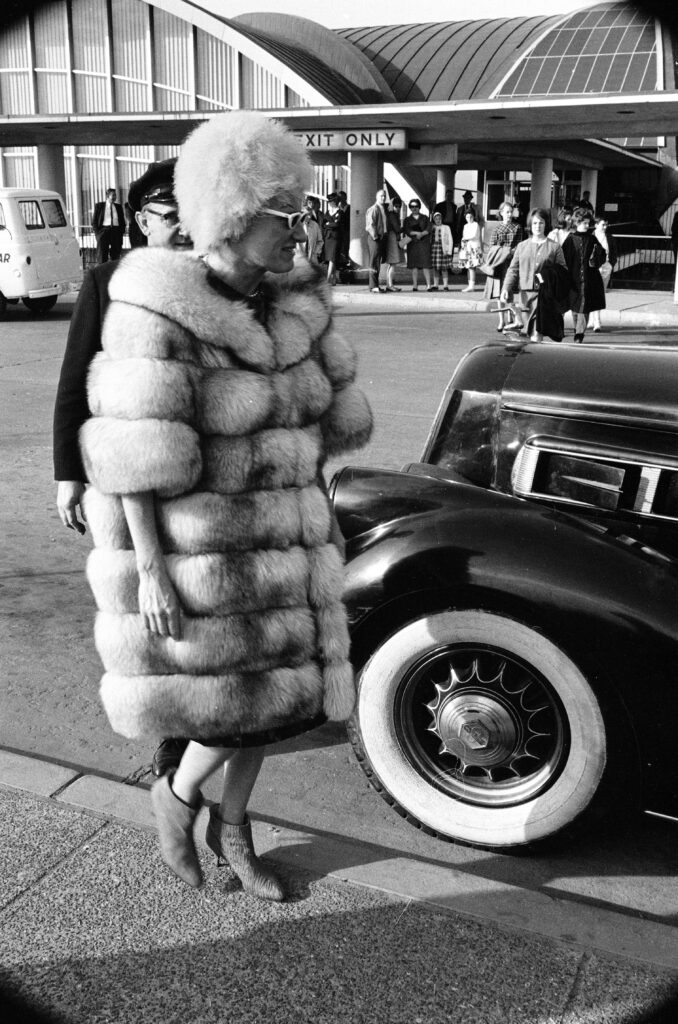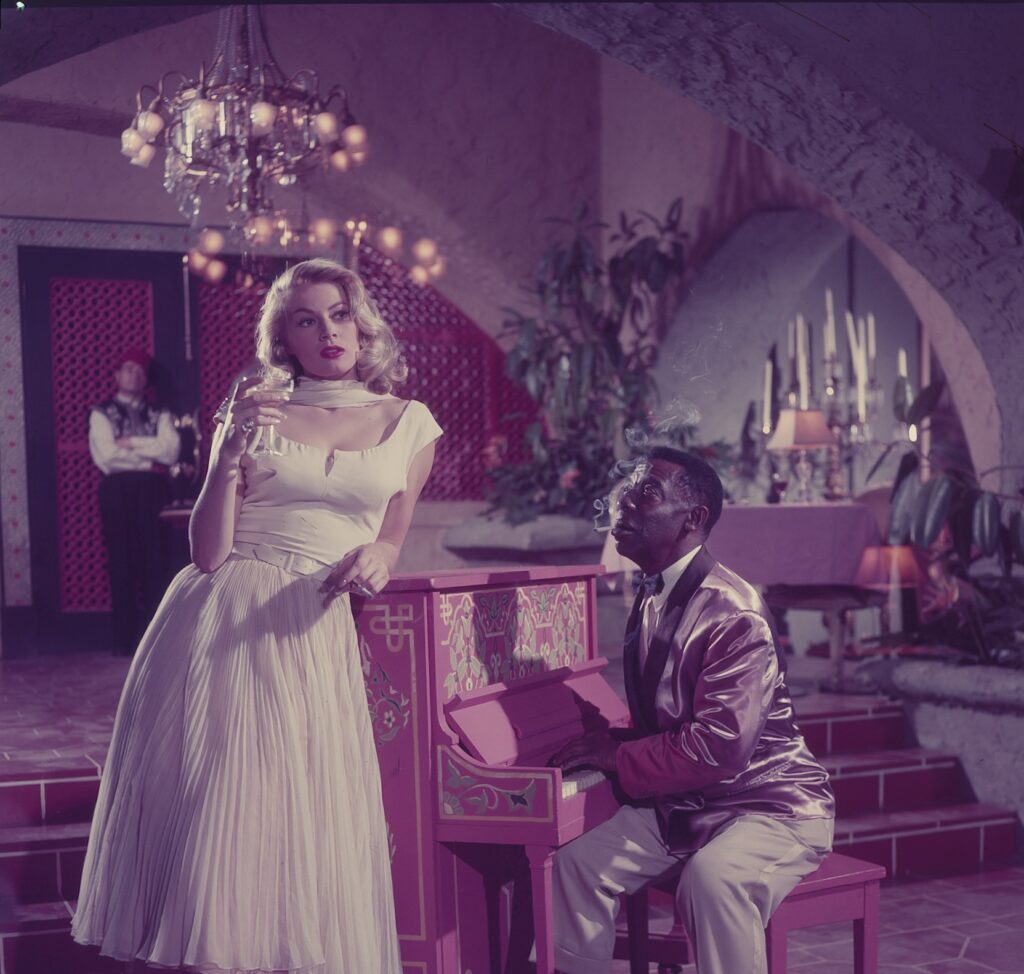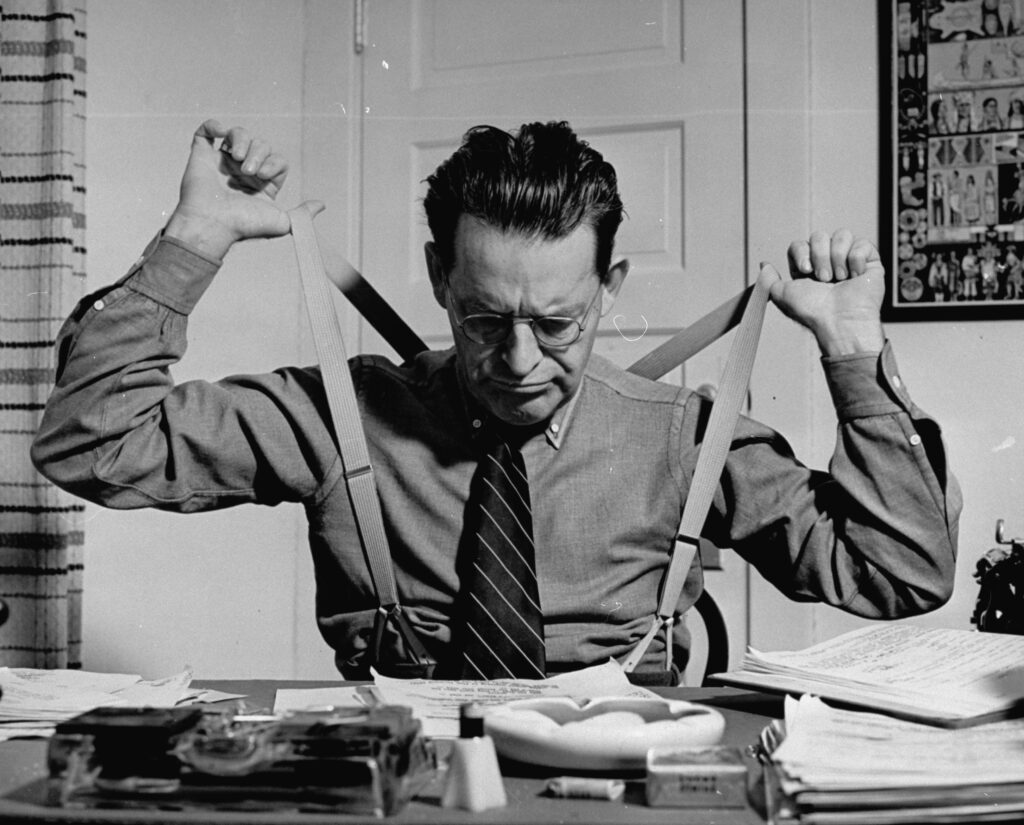This collection of LIFE photos of comedy legends proves one thing definitively: There’s a lot of ways to be funny.
Many take the broad approach, of course. The Three Stooges, for example, appear in their photos with eyes popping, arms akimbo and so forth. The masters of slapstick rode that shtick into the hearts of comedy-loving children for generations.
But there are other ways to get a laugh. Look at Bob Hope for example. His expressions in this photos capture his signature style: he is smart, aware, amused by it all. He was funny in large part because of how he reacted to what was going on about him.
You could say the same for Jacques Tati, the adored French comedian who came to New York in 1958 for a movie premiere and brought a LIFE photographer along to for a day of his distinct version of clowning as he moved about the city, in a befuddled battle with the modern world (including modern art, when he stops by MoMA).
Phil Silvers is the impish trickster, always working a hustle, and he did in his most beloved character, Sergeant Bilko.
Phyllis Diller, it becomes clear in her pictures, was really ahead of her time, and not just because of she was a pioneering figure for female stand-up comedians. In the photos of her with a giant mink and with her preposterous collections, she looks like she was parodying the Kardashians a half-century before their show came on the air.
Another lesson to take from this collection is that while comedy can be heavily verbal, so much of a performer’s particular style and wit can come through in a still photograph. Consider the picture of photos of Ernie Kovacs, the inventive and influential satirist who was the subject of a 1957 LIFE cover story. The photos include a staged shot of Kovacs eating dinner with his family, with everyone, and especially his wife Edie, looking quite distant and miserable. In another photo Kovacs and Edie are in bed together, watching separate televisions, in another subversion of expectation. No canned versions of domestic bliss here, although the caption for that photo did quote Kovacs as saying, “Edie’s never said `Get that cigar out of here before I tear your arm off,'” and for that I am grateful….I love her for that.”
And in a postscript note: the search for photos of comedy legends showed a surprising number of photos in which they were dancing: Bob Hope, Jackie Gleason, Jerry Lewis—even Johnny Carson tries out some steps on stage with soul legend James Brown. Jack Benny’s body language shows a physical grace as he entertains the troops. Perhaps it’s a throwback to when the comedy world’s proving grounds were vaudeville rather than standup or Saturday Night Live. Whatever a case, some of these the old-time funny people knew how to move.

Bob Hope during the rehearsals for the 1958 Academy Awards.
Leonard McCombe The LIFE Picture Collection/Shutterstock

Bob Hope, 1962.
Allan Grant The LIFE Picture Collection/Shutterstock

Bob Hope on the set of the 1958 television movie version of Roberta.
Francis Miller The LIFE Picture Collection/Shutterstock

Comedian Bob Hope (left) with Soupy Sales (second from right) and Shirley MacLaine, their faces covered with remnants of cream pies, 1962.
Allan Grant The LIFE Picture Collection/Shutterstock

A Milton Berle joke slayed Tony Curtis, Dean Martin, and publicist Warran Cowan. “Show Miltie a curtain, he takes a bow,'” said Dean.
Allan Grant The LIFE Picture Collection/Shutterstock

Dean Martin and Jerry Lewis at the Copacabana, 1949.
Ralph Morse/Life Pictures/Shutterstock

Dean Martin and Jerry Lewis at the Copacabana, 1949.
Ralph Morse/Life Pictures/Shutterstock

Bob Hope with Dean Martin and Jerry Lewis in 1950
Howard Sochurek The LIFE Picture Collection/Shutterstock

The Three Stooges performed a skit, 1959.
Michael Rougier The LIFE Picture Collection/Shutterstock

The Three Stooges performed a skit, 1959.
Michael Rougier The LIFE Picture Collection/Shutterstock

The Pickle Queen posed with the Three Stooges during National Pickle Week, 1949.
Francis Miller The LIFE Picture Collection/Shutterstock

Comedian Phil Silvers, in the character of Sgt. Bilko, shuffling cards on his television show.
Yale Joel/Life Pictures/Shutterstock

Gracie Allen and George Burns, 1958. On the wall behind them is a photo of the pair, in a similar pose, from their days as vaudeville performers.
Allan Grant/Life Pictures/Shutterstock

Actor George Burns (R) and actor Jack Benny (L) rehearsed a scene on the George Burns Show, 1958.
Allan Grant/Life Pictures/Shutterstock

Entertainer Jack Benny performed bits for troops stationed in Korea, 1951.
Michael Rougier/The LIFE Picture Collection © Meredith Corporation

Jack Benny and Carol Burnett in a comedy skit, 1962.
Allan Grant/Life Pictures/Shutterstock

The Marx Brothers–(Fore L-R) Harpo, Chico, Groucho and (Rear L-R) Zeppo and Gummo), 1938.
Peter Stackpole/Life Pictures/Shutterstock

Comedian Martha Raye, rehearsing for her TV show, 1954
Michael Rougier/Life Pictures/Shutterstock

Martha Raye rehearsed for her TV show with boxer Rocky Graziano, 1954.
Michael Rougier/Life Pictures/Shutterstock

Comedian Martha Raye on her TV show, 1954
Michael Rougier/Life Pictures/Shutterstock

Comedian Dick Gregory, 1961.
Robert W. Kelley/Life Pictures/Shutterstock

Bob Newhart in 1961.
Allan Grant The LIFE Picture Collection/Shutterstock

Peter Sellers, played the piano at home with his wife, Britt Ekland, in Beverly Hills, 1964.
Allan Grant The LIFE Images Collection/Shutterstock

Actor Flip Wilson took his Rolls Royce on a road trip, 1972.
John Dominis/The LIFE Picture Collection © Meredith Corporation

Jack Lemmon in The Apartment, 1960.
Grey Villet The LIFE Picture Collection/Shutterstock

French actor Jacques Tati in New York City, 1958.
Yale Joel/Life Pictures/Shutterstock

French actor Jacques Tati looked at the high ceiling of a New York City lobby, 1958.
Yale Joel/Life Pictures/Shutterstock

Jacques Tati examined a sculpture by Max Ernst at the Museum of Modern Art, 1958.
Yale Joel/Life Pictures/Shutterstock

Mike Nichols and Elaine May doing skit on recent TV scandals during “Fabulous Fifties” TV special, 1960.
Alfred Eisenstaedt/Life Pictures/Shutterstock

Comic Ernie Kovacs having dinner at home with his wife, Edie Adams, and his two daughters by a previous marriage, 1958.
Ralph Morse/Life Pictures/Shutterstock

Actress Barbara Loden had her face made up for spoof of a cosmetics ad to appear for an Ernie Kovacs special, with a TV filter helping to complete the gag, 1958.
Ralph Morse/Life Pictures/Shutterstock

Comic Ernie Kovacs at home in bed watching twin TV sets with his wife Edie Adams, 1958. Kovacs remarked, “Edie’s never said `Get that cigar out of here before I tear your arm off,'” and for that I am grateful….I love her for that.”
Ralph Morse/Life Pictures, Shutterstock

Phyllis Diller, wearing a fox fur coat and high-heeled half boots, is picked up by a driver sent by her husband at the St. Louis airport, April 1963.
Francis Miller/Life Pictures/Shutterstock

Phyllis Diller sits amid a large collection of hat boxes in the basement of her St. Louis home, 1963.
Francis Miller/Life Pictures/Shutterstock

Phyllis Diller read the names of the well-known (including Frank Sinatra, Vic Damone and the Vagabonds) and the not so well-known on a wall after circling her own name (center), 1963.
Francis Miller/Life Pictures/Shutterstock

Entertainer Jackie Gleason (C) executing his famous How Aweet It Is dance wlhile the chorus girls are taking a bow behind him, 1953.
Lisa Larsen/Life Pictures/Shutterstock

Actors Jackie Gleason (L) and Gene Kelly (C) casually tap dancing Ed Sullivan during visit to Gleason’s studio, 1967
Arthur Schatz/Life Pictures/Shutterstock

Singer James Brown (R) teaching talk show host Johnny Carson how to dance, 1967.
Arthur Schatz/Life Pictures/Shutterstock

Johnny Carson, host of The Tonight Show, 1967.
Arthur Schatz/Life Pictures/Shutterstock

Johnny Carson in his Manhattan apartment, 1967.
Arthur Schatz/Life Pictures/Shutterstock

Johnny Carson and his Tonight Show cohost Ed McMahon, 1967.
Arthur Schatz/Life Pictures/Shutterstock

Rodney Dangerfield (left) and Joan Rivers (right) wrapped up Dick Cavett in a scene from Portnoy’s Complaint, 1969.
Arthur Schatz/Life Pictures/Shutterstock

Comedian Henry Youngman (left) in a steam cabinet in Hot Springs, Arkansas, 1960.
Francis Miller/Life Pictures/Shutterstock

Henry Youngman drying out after steam bath in Hot Springs, Arkansas, 1960.
Francis Miller/Life Pictures/Shutterstock














































































































